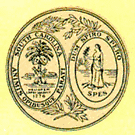The Making of the 50 States: South Carolina
Part 2: The Rest of the Story South Carolina turned out to be one of the major ports of the American colonies. South Carolina traders in particular enjoyed the protection of the British Navy that the Navigation Acts allowed. By the time of the Revolutionary War, South Carolina was one of the richest of the 13 Colonies. Its citizens, like those in other colonies, resented what they saw as British interference in their lives. The Stamp Act, the Townshend Acts, and other taxes convinced the people of South Carolina that Great Britain didn't really have their best interests in mind. They were only too glad to raise militiamen and soldiers to fight in the war. One early skirmish set the tone for the war, much like the Battle of Bunker Hill, in the north. An early British target was a newly built fort on Sullivan's Island, in Charleston Harbor. With the British Army and Navy pushing the Americans all over New York and New Jersey in the north, the American people needed some sort of moral boost. They got one on June 28, 1776, just days before the signing of the Declaration of Independence, when South Carolina successfully defended the attack on the Sullivan's Island fort. Because the logs of the fort were from palmetto trees, which grew on the island, they were the key to
The colony was the site of many major battles, including Camden, Cowpens, and Kings Mountain. Charleston was eventually seized and held by the British (under General Henry Clinton) for several years. The victory, in the end, belonged to the American Army, however. Patriots under Nathanael Greene eventually liberated Charleston and the entire colony, before ending the war with the entrapment of General Charles Cornwallis at Yorktown, Virginia.
First page > In the Beginning > Page 1, 2
|
|
Social Studies for Kids
copyright 2002–2024
David White



 the successful defense: The trees were so spongy that cannon balls could not penetrate them but instead would get wedged in them. With no way to bring down the walls and lacking the manpower to overrun the fort, the British withdrew. It was a small yet extremely important victory for the beleagured American forces: It allowed Charleston, one of the colonies' leading ports and commerce centers, remain in American hands, free to accept food and ammunition from other countries (notably France) and ship it all to not only South Carolina troops but also troops elsewhere in the war zone. After this battle, the fort was named for the American commander, William Moultrie.
the successful defense: The trees were so spongy that cannon balls could not penetrate them but instead would get wedged in them. With no way to bring down the walls and lacking the manpower to overrun the fort, the British withdrew. It was a small yet extremely important victory for the beleagured American forces: It allowed Charleston, one of the colonies' leading ports and commerce centers, remain in American hands, free to accept food and ammunition from other countries (notably France) and ship it all to not only South Carolina troops but also troops elsewhere in the war zone. After this battle, the fort was named for the American commander, William Moultrie. Another source of inspiration for South Carolinians was the continual harassment of British troops by
Another source of inspiration for South Carolinians was the continual harassment of British troops by  The interlude of the
The interlude of the 
